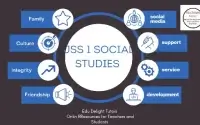Exploring the World of Poetry: Understanding Its Beauty Literature English Grammar JSS 3 First Term Lesson Notes Week 5
Literature Lesson Notes: Revising Poetry
Subject: Literature
Class: JSS 3
Term: First Term
Week: 5
Age: Approximately 14-15 years
Topic: Revising Poetry
Sub-topic: Understanding Elements of Poetry
Duration: 2 periods (80 minutes)
Behavioural Objectives:
By the end of the lesson, students should be able to:
- Define poetry and its main features.
- Identify different types of poems and their characteristics.
- Analyze a given poem and discuss its themes and literary devices.
- Create a simple poem using learned structures.
Key Words:
- Poetry
- Rhyme
- Stanza
- Imagery
- Theme
Set Induction:
The teacher will start the lesson by reading a popular poem aloud. Students will discuss their initial thoughts and feelings about it.
Entry Behaviour:
Students should be familiar with basic literary concepts and have previously studied some poems.
Learning Materials:
- Recommended Texts:
- Eyisi J. et al. (2012). New Concept English for Junior Secondary Schools
- Osajie E.O. (2002). Complete Guide to Literature-in-English for Colleges
- Handouts with excerpts of poems
- Whiteboard and markers
Instructional Materials:
- Projector for displaying poetry examples
- Copies of various poems for group work
Building Background / Connection to Prior Knowledge:
Students will recall elements of prose and drama studied in previous weeks and discuss how poetry differs from these forms.
Embedded Core Skills:
- Critical thinking
- Creative writing
- Teamwork and collaboration
Content
- Definition of Poetry:
- Poetry is a form of literary art that uses aesthetic and rhythmic qualities of language to evoke meanings and emotions.
- Main Features of Poetry:
- Rhyme: Repetition of sounds at the end of lines.
- Stanza: A group of lines forming a unit in a poem.
- Imagery: Descriptive language that creates sensory experiences.
- Theme: The underlying message or main idea of the poem.
- Form: The structure or pattern of a poem.
- Types of Poems:
- Lyric: Expresses personal emotions or thoughts.
- Narrative: Tells a story.
- Sonnet: A 14-line poem with a specific rhyme scheme.
- Haiku: A three-line poem with a 5-7-5 syllable structure.
- Free Verse: No specific rhyme or rhythm.
Evaluation
Fill-in-the-Blank Questions:
- A poem that tells a story is called a __________.
a) Lyric
b) Narrative
c) Sonnet
Answer: b) Narrative - The repeated sounds at the end of lines in a poem are called __________.
a) Stanzas
b) Rhyme
c) Themes
Answer: b) Rhyme - A __________ poem has no specific rhyme or rhythm.
a) Free Verse
b) Haiku
c) Lyric
Answer: a) Free Verse - The main idea of a poem is known as its __________.
a) Imagery
b) Theme
c) Form
Answer: b) Theme - In a sonnet, there are __________ lines.
a) 12
b) 14
c) 16
Answer: b) 14 - A poem that expresses personal feelings is called a __________.
a) Narrative
b) Lyric
c) Sonnet
Answer: b) Lyric - The structure of a poem refers to its __________.
a) Theme
b) Form
c) Rhyme
Answer: b) Form - Imagery in poetry helps create __________ experiences for the reader.
a) Sensory
b) Emotional
c) Mental
Answer: a) Sensory - A __________ is a three-line poem.
a) Sonnet
b) Haiku
c) Lyric
Answer: b) Haiku - The repeated sounds within a stanza create a sense of __________.
a) Harmony
b) Structure
c) Imagery
Answer: a) Harmony - A poem with a specific rhyme scheme is often called a __________.
a) Free Verse
b) Sonnet
c) Narrative
Answer: b) Sonnet - The emotional quality of a poem is often expressed through its __________.
a) Stanza
b) Imagery
c) Theme
Answer: b) Imagery - __________ is a type of poem that is often written to capture a moment in nature.
a) Sonnet
b) Haiku
c) Lyric
Answer: b) Haiku - The __________ of a poem can vary from one poem to another, affecting its overall impact.
a) Structure
b) Rhyme
c) Theme
Answer: a) Structure - Analyzing poetry involves looking at its __________ and meaning.
a) Form
b) Rhyme
c) Imagery
Answer: a) Form
Class Activity Discussion
FAQ with Answers:
- What is poetry?
Poetry is a literary form that uses expressive language to convey feelings and ideas. - What are the main features of poetry?
Main features include rhyme, stanza, imagery, theme, and form. - How do I identify a narrative poem?
A narrative poem tells a story with characters and a plot. - What is the purpose of imagery in poetry?
Imagery creates vivid mental pictures that engage the reader’s senses. - What is a sonnet?
A sonnet is a 14-line poem that often explores themes of love. - What makes a lyric poem different from other types?
A lyric poem expresses personal thoughts and feelings rather than telling a story. - What does it mean for a poem to be in free verse?
Free verse poetry does not follow a specific rhyme or rhythm scheme. - How can I analyze a poem?
Look for themes, imagery, and how the poet uses language to convey emotion. - Why is rhyme important in poetry?
Rhyme creates a musical quality and helps to emphasize certain words or ideas. - What types of imagery can be used in poetry?
Imagery can involve sight, sound, taste, touch, and smell. - How does the structure of a poem affect its meaning?
The structure can influence how the poem is read and understood, impacting its emotional effect. - Can a poem have more than one theme?
Yes, many poems explore multiple themes simultaneously. - What is a haiku?
A haiku is a traditional Japanese poem with three lines following a 5-7-5 syllable pattern. - What should I consider when writing my own poem?
Think about your feelings, imagery, and whether you want to use rhyme or free verse. - How do I find meaning in a poem?
Read it multiple times, look for key words, and consider what emotions or thoughts it evokes.
Presentation
Step 1: The teacher revises the previous topic, which was “Understanding Prose and Drama.”
Step 2: The teacher introduces the new topic, “Revising Poetry,” by discussing its significance in literature.
Step 3: The teacher allows students to share their thoughts on poetry, encouraging them to express their interpretations.
Teacher’s Activities
- Facilitate discussions about poetry.
- Guide students in analyzing poems.
- Provide feedback on students’ contributions.
Learners’ Activities
- Participate in group discussions.
- Analyze assigned poems.
- Create their own poems.
Assessment
- Monitor group work and discussions.
- Collect and review students’ created poems.
Evaluation Questions
- Define poetry.
Answer: Poetry is a literary form that uses expressive language to convey feelings and ideas. - List three features of poetry.
Answer: Rhyme, stanza, imagery. - Explain the difference between a lyric and a narrative poem.
Answer: A lyric poem expresses personal feelings, while a narrative poem tells a story. - Describe what imagery means in poetry.
Answer: Imagery is descriptive language that creates sensory experiences. - What makes a poem a sonnet?
Answer: A sonnet is a 14-line poem with a specific rhyme scheme. - What is the purpose of rhyme in poetry?
Answer: Rhyme creates a musical quality and helps to emphasize certain words or ideas. - What is free verse poetry?
Answer: Free verse poetry does not follow a specific rhyme or rhythm scheme. - How can I identify the theme of a poem?
Answer: Look for the main message or idea expressed throughout the poem. - What is the structure of a haiku?
Answer: A haiku consists of three lines with a 5-7-5 syllable pattern.
- How can imagery enhance a poem?
Answer: Imagery creates vivid mental pictures that engage the reader’s senses.
Conclusion
The teacher will circulate around the classroom, providing feedback and marking students’ poems. The lesson will conclude with a recap of key points discussed.
Related Posts
AVOIDING CRIMINAL BAHAVIOURS


Examination Social Studies Jss 3 Second Term Lesson Notes


IMPREST ACCOUNT AND THE ROLE OF WAGES AND SALARIES UNIT
About The Author
Edu Delight Tutors
Am a dedicated educator with a passion for learning and a keen interest in technology. I believe that technology can revolutionize education and am committed to creating an online hub of knowledge, inspiration, and growth for both educators and students. Welcome to Edu Delight Tutors, where learning knows no boundaries.